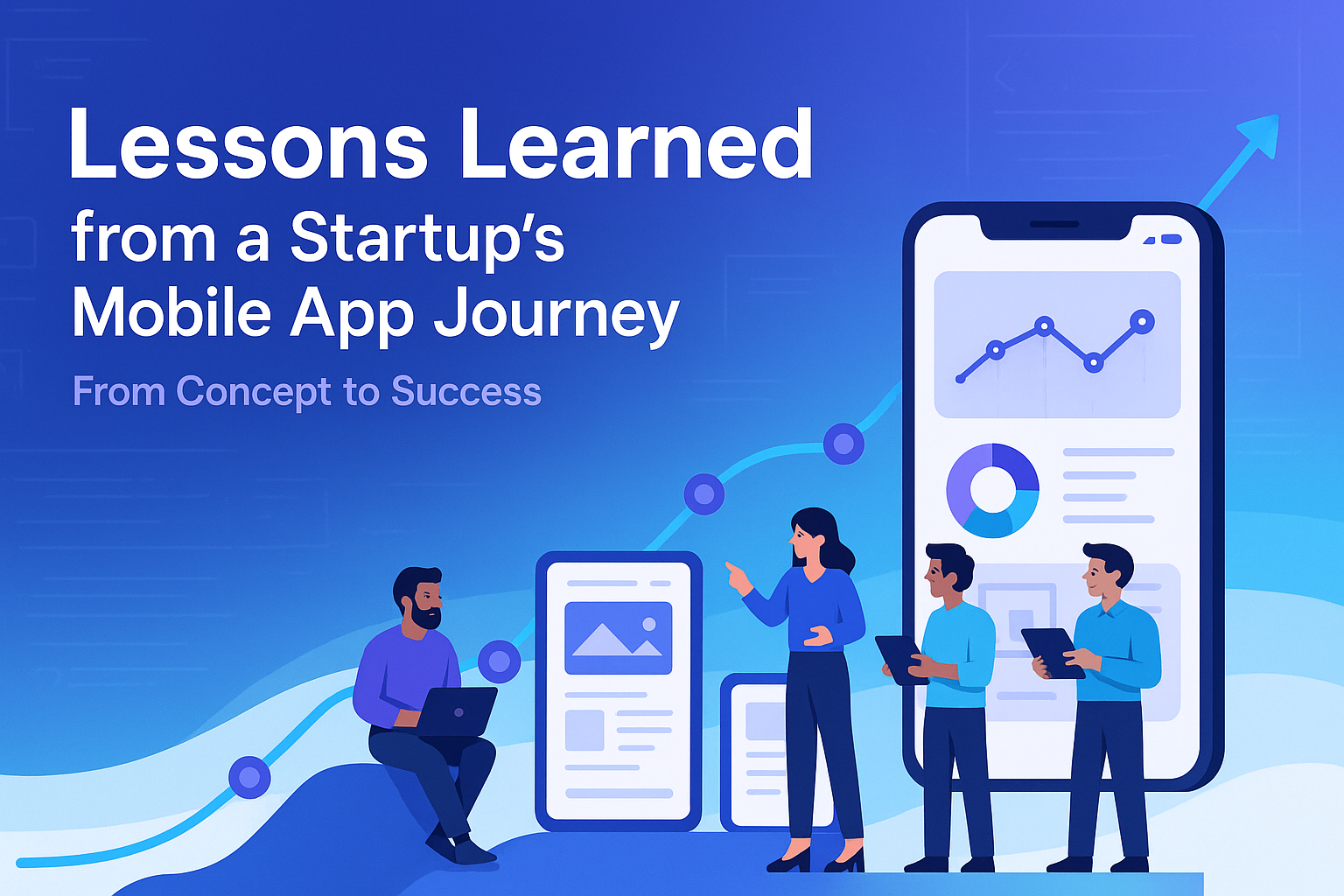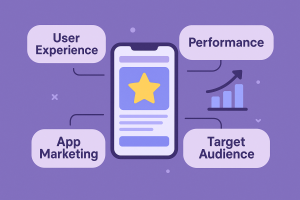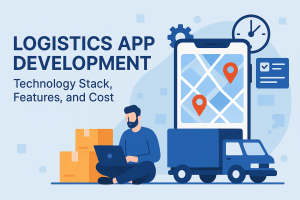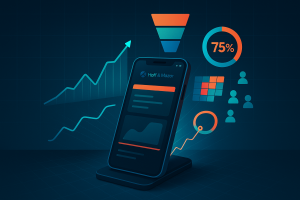The journey from concept to successful app is rarely straightforward, but the lessons learned along the way can be invaluable. This article dives deep into the real-world experiences and critical insights gained from startups that have navigated the complex landscape of mobile app development.
Understanding the Mobile App Ecosystem in 2025
The mobile app market continues to evolve at breakneck speed. With over 7 million apps available across various platforms and global app revenue exceeding $935 billion, the opportunities are vast—but so are the challenges. For startups entering this competitive space, understanding the current landscape is crucial before writing the first line of code.
Today’s successful mobile apps aren’t just functional tools; they’re comprehensive solutions that seamlessly integrate into users’ daily lives. The bar for quality, performance, and user experience has never been higher, making the development journey both exciting and daunting for startups.
Starting with a Strong Foundation: The Concept Phase
Identifying a Genuine Problem
The most successful startup apps begin with identifying a real problem that needs solving. Many failed apps can trace their downfall to a fundamental flaw: creating a solution in search of a problem.
“We spent six months building what we thought was revolutionary, only to discover users didn’t actually need it,” confesses the founder of a now-pivoted fintech startup. “If we had spent more time understanding our target audience’s pain points, we could have saved tremendous resources.”
This sentiment echoes across the startup landscape. Market research isn’t just an academic exercise—it’s the difference between building something people want versus something that will be ignored in an oversaturated marketplace.
Validating Your Idea
Before investing significant resources, successful startups validate their app concept through:
- User interviews and surveys
- Competitive analysis
- Minimum viable product (MVP) testing
- Beta testing with real users
- Analysis of market trends and potential demand
Creating a detailed app development process helps startups navigate these early stages with clarity and purpose. This structured approach ensures that validation isn’t skipped in the excitement of bringing an idea to life.
Defining Clear Goals and Metrics
Setting clear, measurable objectives from the outset gives direction to the entire development journey. Rather than vague aspirations like “creating a popular app,” successful startups define specific metrics:
- User acquisition targets
- Retention rates
- Engagement metrics
- Revenue goals
- Specific problem-solving outcomes
These metrics not only guide development decisions but also provide benchmarks for measuring success as the app evolves.
Choosing the Right Development Approach
Native vs. Cross-Platform Development
One of the earliest and most consequential decisions startups face is whether to build native apps for each platform or utilize cross-platform frameworks. This choice influences everything from development costs to performance and user experience.
Native development offers platform-specific advantages:
- Optimal performance
- Full access to device features
- Platform-consistent user experience
- Better long-term maintainability
However, many startups find success with cross-platform approaches like React Native or Flutter, which allow code sharing across platforms and faster time-to-market.
“We initially went native for both iOS and Android, maintaining separate codebases,” shares a startup founder. “The maintenance overhead became unsustainable for our small team. Switching to Flutter cut our development time by 40% and allowed us to roll out features simultaneously across platforms.”
When considering which approach is right for your startup, exploring resources like cross-platform mobile app development can provide valuable insights into the pros and cons of each option.
Building In-House vs. Partnering with Experts
Another critical decision is whether to build an in-house development team or partner with an experienced mobile app development company. This choice impacts not just the quality of the final product but also development timelines and budget considerations.
For many startups, the ideal approach combines internal product leadership with external technical expertise. “Having our product vision executed by experienced developers made all the difference,” notes the CEO of a healthcare startup. “We focused on what we knew best—our industry and users—while our development partner handled the technical complexities.”
Startups lacking technical co-founders often find that partnering with an offshore mobile app development team provides the technical expertise they need while keeping costs manageable. These partnerships can be particularly valuable when navigating the complexities of modern app architecture.
Design: The Make-or-Break Element
User-Centered Design Principles
Perhaps the most transformative lesson from successful mobile apps is the paramount importance of user-centered design. Apps that gain traction put users at the center of every design decision.
“We completely rebuilt our app after our first version failed to gain traction,” admits a startup founder. “The difference was simple but profound—we stopped designing for ourselves and started designing for our actual users.”
Design isn’t merely about aesthetics; it encompasses the entire user experience:
- Intuitive navigation
- Minimal friction points
- Clear visual hierarchy
- Accessibility features
- Consistent design language
Startups that invest in creating responsive mobile UI see significantly higher engagement rates and lower abandonment. The correlation between thoughtful design and business success is unmistakable.
Prototype, Test, Iterate
Successful startups rarely get everything right on the first try. Instead, they embrace an iterative approach that involves:
- Creating interactive prototypes
- Testing with real users
- Gathering specific feedback
- Implementing changes
- Repeating the process
This approach minimizes the risk of major design flaws making it into the final product. “Our prototype testing revealed issues we never anticipated,” shares a startup founder. “Users were getting confused at a critical conversion point—something our team thought was completely intuitive.”
Tools like Figma and Adobe XD have made prototyping more accessible than ever, allowing startups to validate designs before committing to code. This process saves both time and development resources in the long run.
Technical Excellence: Building for Performance and Scale
Architecture That Scales
As startups grow, their app architecture faces increasing demands. Many founders share painful stories of having to completely rebuild their apps after initial success because the original architecture couldn’t handle growth.
“We hit 10,000 users and our app started crashing regularly,” recalls one founder. “We had to pause new feature development for three months while we rebuilt our backend. The lesson was clear—plan for success from day one.”
Building scalable mobile apps requires thinking beyond immediate needs. Key considerations include:
- Database design for growing data volumes
- API structures that support evolving features
- Caching strategies for improved performance
- Infrastructure that can scale with demand
- Modular code that allows for future expansion
These architectural decisions might seem premature for an app with few users, but they prevent painful reengineering when success arrives.
Performance Optimization
Users have increasingly high expectations for app performance. Even a one-second delay in loading time can significantly impact engagement and retention metrics.
“We lost 30% of our users due to performance issues,” shares a startup founder. “Our app was feature-rich but sluggish. We learned the hard way that users value speed over additional features.”
Successful startups prioritize:
- Fast loading times
- Smooth animations and transitions
- Efficient battery usage
- Minimal data consumption
- Responsive UI even under poor network conditions
These performance aspects require ongoing attention rather than a one-time effort. Apps that maintain excellent performance across updates consistently outperform feature-identical competitors that neglect these aspects.
Security: Non-Negotiable from Day One
In today’s privacy-conscious world, data security isn’t just a technical requirement—it’s a fundamental user expectation. Startups that experience security breaches rarely recover user trust.
“A small security oversight cost us everything,” shares a founder whose app suffered a data breach six months after launch. “We had to shut down not because we couldn’t fix the issue, but because users wouldn’t return even after it was resolved.”
Startups building successful apps implement security measures from the beginning:
- Data encryption at rest and in transit
- Secure authentication methods
- Regular security audits
- Compliance with relevant regulations (GDPR, CCPA, etc.)
- Clear privacy policies and user consent mechanisms
These measures protect not just user data but the startup’s reputation and future. The investment in proper security practices yields significant returns in user trust and business longevity.
Launch Strategies: Making a Market Impact
Planning the Perfect Launch
After months of development, many startups rush their app launch, missing opportunities to maximize impact. Successful launches are carefully orchestrated campaigns rather than simple app store submissions.
“Our first app launched with zero fanfare and predictably got zero attention,” admits a startup founder. “For our second product, we spent two months building anticipation before launch. The difference in initial traction was night and day.”
Effective launch strategies include:
- Pre-launch marketing and audience building
- Beta testing with influential users
- Press outreach and media relationships
- Launch-day promotions and incentives
- Post-launch engagement plans
These coordinated efforts help new apps overcome the visibility challenge in crowded app stores.
App Store Optimization (ASO)
Even brilliant apps can fail if users never discover them. App Store Optimization has become increasingly sophisticated, requiring deliberate strategy rather than keyword stuffing.
“We were getting buried in search results despite having better reviews than competitors,” shares a founder. “Revamping our ASO strategy increased our downloads by 340% without changing the app itself.”
Key ASO elements include:
- Strategic keyword research and implementation
- Compelling screenshots and preview videos
- Clear, benefit-focused descriptions
- Optimized app titles and subtitles
- Rating and review management
Well-executed ASO gives startups a fighting chance in competitive categories, driving organic discovery without costly user acquisition campaigns.
Post-Launch: The Real Journey Begins
Analytics and Data-Driven Iteration
Launch day marks the beginning, not the end, of the app development journey. Successful startups implement robust analytics from day one, tracking metrics that matter to their specific business model.
“Our initial assumptions about user behavior were completely wrong,” reveals a founder whose app now has millions of users. “The feature we thought would be central was barely used, while a ‘minor’ feature became our main value proposition. Without analytics, we would have continued investing in the wrong direction.”
Effective analytics implementation includes:
- User journey tracking
- Feature usage metrics
- Conversion funnels
- Retention analysis
- Crash and error reporting
These insights enable startups to iterate based on real user behavior rather than assumptions or anecdotal feedback.
Listening to User Feedback
Perhaps the most consistent pattern among successful app startups is their relentless focus on user feedback. This goes beyond monitoring reviews to establishing ongoing dialogue with users.
“The feature that ultimately made our app successful came directly from user suggestions,” shares a founder. “We built something we never would have conceived ourselves because we maintained open channels with our early adopters.”
Effective feedback channels include:
- In-app feedback mechanisms
- User interviews and surveys
- Community forums and social media
- Beta testing programs
- Direct customer support interactions
By creating a culture that values and responds to feedback, startups can evolve their apps in directions that truly serve user needs.
Managing Technical Debt and App Evolution
Balancing Speed and Quality
The pressure to release features quickly often leads to accumulated technical debt—shortcuts and compromises that become increasingly costly over time.
“We moved fast and broke things, as the Silicon Valley mantra goes,” recounts a founder. “Then we spent a year fixing those broken things while our competitors passed us by. Moving fast only works if you’re not constantly stopping to clean up messes.”
Successful startups find ways to balance speed with sustainable development practices:
- Regular code refactoring
- Automated testing implementation
- Documentation discipline
- Periodic technical debt “sprints”
- Clear quality standards for all releases
These practices require discipline but prevent the crippling slowdown that affects many startups as their codebases grow.
Planning for the Long Term
The most successful apps evolve significantly over time, sometimes bearing little resemblance to their initial versions. This evolution requires both technical flexibility and strategic vision.
“Our original app was essentially v0.1 of what we have today,” reflects a founder whose app now serves millions. “The difference is that we built it with major evolutions in mind, even though we couldn’t predict exactly what those would be.”
From concept to launch, startups building for the long term consider:
- Feature roadmaps with deliberate sequencing
- Technology choices that won’t become obsolete
- User growth scenarios and scaling points
- Market evolution and competitive responses
- Potential business model transitions
This forward-thinking approach positions startups to adapt as markets, technologies, and user expectations evolve.
Navigating Partnership and Integration Challenges
Third-Party API Integrations
Modern apps rarely exist in isolation. Most leverage third-party services for everything from payments to location services and social features. These integrations create both opportunities and potential pitfalls.
“A critical API we relied on changed their pricing model overnight,” shares a founder. “Our costs increased tenfold, making our business model unsustainable. We hadn’t built any alternatives or negotiated guarantees.”
Integrating third-party APIs requires careful consideration:
- Dependency risks and contingency plans
- Cost structures and scaling implications
- Data privacy and security concerns
- Performance impacts on the overall app
- Long-term stability of the provider
Startups that navigate these considerations successfully gain the benefits of third-party integrations while minimizing associated risks.
Financial Reality: Managing Development Costs
Budgeting for the Full Journey
One of the most common startup failures stems from underestimating the true cost of app development. The initial build typically represents only 30-40% of the first-year costs.
“We ran out of money right after launch,” confesses a founder. “We had nothing left for marketing, support, or iteration. The app was technically complete but had no chance of success without these critical components.”
Comprehensive budgeting includes:
- Initial development costs
- Quality assurance and testing
- Launch marketing campaigns
- Ongoing maintenance and updates
- Server and infrastructure costs
- Customer support resources
Startups that account for these full lifecycle costs are better positioned to sustain their apps through the critical early adoption phase.
Monetization Strategy Evolution
Monetization strategies often evolve as startups gain real-world data on user behavior and willingness to pay. Successful apps frequently pivot their revenue models based on these insights.
“We launched with a subscription model that users rejected,” shares a founder. “Switching to freemium with in-app purchases increased our revenue by 8x within three months. Users were willing to pay, just not in the way we initially expected.”
Effective monetization approaches include:
- Testing multiple revenue models
- Analyzing user segments and their preferences
- A/B testing pricing and presentation
- Gradually introducing monetization features
- Balancing immediate revenue with user growth
This experimental mindset allows startups to find sustainable revenue models that align with user expectations.
Team Dynamics and Talent Management
Building the Right Team
The composition of the development team profoundly influences both the app’s quality and the startup’s ability to iterate quickly. Technical skills alone rarely determine success.
“Our first development team was technically brilliant but couldn’t communicate effectively with our non-technical stakeholders,” recalls a founder. “Our second team had a broader skill set and produced a more coherent product despite having less specialized expertise.”
Successful app development teams typically balance:
- Technical excellence across relevant domains
- Communication and collaboration skills
- Problem-solving mindset
- Adaptability to changing requirements
- Alignment with the startup’s mission
Whether building in-house or deciding to hire mobile app developer teams externally, these balanced capabilities drive better outcomes than technical skills alone.
Knowledge Transfer and Documentation
As startups grow, the need for effective knowledge sharing becomes increasingly apparent. Many face crises when key team members depart, taking critical institutional knowledge with them.
“Our lead developer left, and we realized how much of the architecture existed only in his head,” shares a founder. “It took us months to regain momentum because we hadn’t prioritized documentation or knowledge sharing.”
Sustainable development practices include:
- Comprehensive code documentation
- Architecture decision records
- Onboarding processes for new team members
- Regular knowledge sharing sessions
- Collaboration tools that preserve context
These practices create resilience against the inevitable team changes that startups experience.
Marketing and User Acquisition Lessons
Finding Sustainable Acquisition Channels
The “build it and they will come” myth has claimed countless promising apps. Successful startups develop systematic approaches to user acquisition that grow alongside their products.
“We burned through our marketing budget in two weeks with nothing to show for it,” admits a founder. “Then we discovered that niche online communities loved our app and would share it organically. That free channel outperformed our paid efforts by orders of magnitude.”
Effective user acquisition strategies typically include:
- Identifying and testing multiple channels
- Calculating and optimizing acquisition costs
- Building referral mechanisms into the app
- Content marketing aligned with user needs
- Community building around the app’s purpose
These diverse approaches create more sustainable growth than reliance on paid advertising alone.
Retention: The Often-Overlooked Metric
Many startups focus heavily on user acquisition while neglecting retention—a costly mistake given that acquiring new users typically costs 5-25 times more than retaining existing ones.
“We celebrated hitting 100,000 downloads, not realizing we were losing 90% of users within a week,” shares a founder. “Our actual active user base was a fraction of what our download numbers suggested.”
Mobile app redesign for user engagement often becomes necessary when startups finally recognize retention issues. Successful apps prioritize retention through:
- Thoughtful onboarding experiences
- Early value delivery to new users
- Engagement loops and habit formation
- Regular feature updates and improvements
- Personalization based on user behavior
These retention-focused elements often have a greater impact on growth than pure acquisition efforts.
Legal and Compliance Considerations
The regulatory landscape for mobile apps continues to evolve, with increasing scrutiny around data privacy, accessibility, and consumer protection. Startups that ignore these aspects face existential risks.
“We had to pull our app from the European market due to GDPR compliance issues,” recalls a founder. “The lost revenue and reputation damage could have been avoided with proper legal guidance from the start.”
Critical compliance areas include:
- Data privacy regulations (GDPR, CCPA, etc.)
- Intellectual property protection
- App store policy compliance
- Accessibility requirements
- Industry-specific regulations
While startups can’t eliminate all legal risks, understanding and addressing the major compliance requirements prevents costly disruptions later.
Looking Forward: Emerging Technologies and Trends
Adapting to Platform Evolution
Mobile platforms continually evolve, creating both opportunities and challenges for app developers. Successful startups stay ahead of these changes rather than reacting to them.
“Apple’s privacy changes decimated our marketing strategy overnight,” shares a founder. “Competitors who had been preparing alternative approaches barely felt the impact, while we scrambled to rebuild our acquisition model.”
Forward-thinking startups monitor trends including:
- Platform policy changes
- Hardware advancements
- User behavior shifts
- Emerging interaction models
- Competitive innovations
This anticipatory mindset allows startups to adapt gracefully rather than being blindsided by industry shifts.
Embracing New Capabilities
Technologies like AR, AI, and machine learning are transforming what’s possible in mobile apps. Startups that strategically incorporate these capabilities often leapfrog established competitors.
“Adding AI-driven personalization increased our user engagement by 62%,” notes a founder. “It wasn’t about jumping on a trendy technology—it was about solving our users’ problems in a more effective way.”
When evaluating new technologies, successful startups consider:
- Genuine user benefit vs. novelty factor
- Implementation complexity and maintenance
- Performance impacts and requirements
- User adoption and learning curves
- Competitive differentiation potential
This pragmatic approach to innovation ensures that new technologies serve business goals rather than distracting from them.
Conclusion:
The most important lesson from startup app journeys is perhaps the most obvious yet frequently overlooked: successful app development is never truly “done.” It’s an ongoing process of learning, adapting, and evolving alongside user needs and market realities.
“Three years and fifteen major versions later, we’re still discovering new insights about our users and our product,” reflects a successful founder. “The moment we stop evolving is the moment we start becoming irrelevant.”
For startups embarking on mobile app development, this perspective shift—from project to journey—may be the most valuable mindset adjustment of all. By approaching app development as a continuous process rather than a finite project, startups position themselves for sustainable growth and ongoing innovation.
The mobile app landscape will continue to evolve, but these fundamental lessons remain constant: understand your users deeply, build with quality and scalability in mind, embrace data-driven iteration, and maintain unrelenting focus on the problems you’re solving. Startups that internalize these lessons dramatically improve their odds in the challenging but rewarding world of mobile app development.







